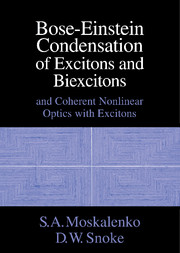Book contents
- Frontmatter
- Contents
- Preface
- 1 Introduction
- 2 Basic Theory of Bose–Einstein Condensation of Excitons
- 3 The Interaction of Condensed Excitons with Lattice Phonons
- 4 Bose–Einstein Condensation of Biexcitons
- 5 Phase Transitions and Thermodynamics of High-Density of Excitons
- 6 The Optical Stark Effect and the Virtual Bose Condensate
- 7 Bose–Einstein Condensation of Mixed States of Excitons and Photons
- 8 Nonequilibrium Kinetics of High-Density Excitons
- 9 Coherent Nonlinear Optics with Excitons
- 10 New Directions
- Appendix A: Properties of Excitons in Cu2O
- Author Index
- Subject Index
6 - The Optical Stark Effect and the Virtual Bose Condensate
Published online by Cambridge University Press: 04 August 2010
- Frontmatter
- Contents
- Preface
- 1 Introduction
- 2 Basic Theory of Bose–Einstein Condensation of Excitons
- 3 The Interaction of Condensed Excitons with Lattice Phonons
- 4 Bose–Einstein Condensation of Biexcitons
- 5 Phase Transitions and Thermodynamics of High-Density of Excitons
- 6 The Optical Stark Effect and the Virtual Bose Condensate
- 7 Bose–Einstein Condensation of Mixed States of Excitons and Photons
- 8 Nonequilibrium Kinetics of High-Density Excitons
- 9 Coherent Nonlinear Optics with Excitons
- 10 New Directions
- Appendix A: Properties of Excitons in Cu2O
- Author Index
- Subject Index
Summary
Nonequilibrium Theory of the Optical Stark Effect in the Excitonic Range of the Spectrum
One of the most important applications of the theory of Bose condensation of excitons is the optical Stark effect, or “AC Stark effect, ” first demonstrated for excitons in Cu2O [1] and since seen in several semiconductors and semiconductor heterostructures (e.g., Refs. 2-5). This effect is a promising tool for the field of optical communications. One of the major interests in this field is the development of all-optical-switching methods, by which light signals are switched on or off directly by other light signals, just as in electronics, electrical signals switch other electrical signals. At the present, most optical communications systems use electrical signals (e.g., electro-optic or acousto-optic devices) to switch the light signals, which means that the limiting bandwidth of the system is controlled by that of the electrical signals, not the optical bandwidth. The optical Stark effect offers this possibility. When one laser beam impinges on a sample, it can drastically alter the excitonic absorption line shape. Therefore a second beam can see either a transparent or an absorbing medium, depending on the presence of the control beam. This is the optical equivalent of a transistor.
The basic effect is shown in Fig. 6.1. When an intense laser is tuned to a photon energy that is just below the excitonic ground state, the exciton ground state is shifted in frequency and the oscillator strength is altered. This leads to a strong reduction in the optical absorption at the original wavelength of the exciton ground state.
- Type
- Chapter
- Information
- Bose-Einstein Condensation of Excitons and BiexcitonsAnd Coherent Nonlinear Optics with Excitons, pp. 201 - 248Publisher: Cambridge University PressPrint publication year: 2000



